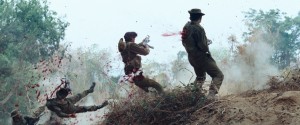Realistic Versus Minimalistic Illustration of Violence
Hillary Chute’s The Texture of Retracing in Marjane Satrapi’s Persepolis dissects the genre of graphic narrative used by Satrapi. She analyzes the elements, the style, and the juxtaposition of comic books that made Persepolis effective. Violence is depicted as ordinary from a child’s imagination through the minimalist style. Although the illustration was simple, Chute explains how it shows the ‘power of the radically inadequate’. It then questions the realistic representation of violence and how it has been normalized.
Satrapi’s depiction of violence is different from mainstream media. She argues that violence has become normal and to show it as realistic desensitizes it (Chute, 99).
Does mainstream media normalizes violence?
One of the most violent movies I have ever seen is Rambo (2008). At the age of 13, watching Vietnamese get massacred scared me to death. The realistic illustration of violence is almost traumatizing for a child to see. Lives weren’t valued. Nobody mourned. Killing became ordinary.
The Godfather (1972) is a mob drama with horrific images as well. Even though it’s not as gory as Rambo, its representation of violence as being part of their lifestyle is almost the same.
There are hundreds of movies and television shows that reduce violence and make it ordinary. However, the trauma it produces to children is still the same. Satrapi’s simple portrayal of violence as seen through the eyes of a child intensify its content. Readers tend to focus more on what Satrapi’s trying to say rather than the images of torture seen in the graphic narrative. Even though it wasn’t as gory, bloody, or realistic as Rambo, the effect it produces globally was staggering.
But if a simple depiction of violence got great reviews, why do mainstream media keep producing violent visualizations?

